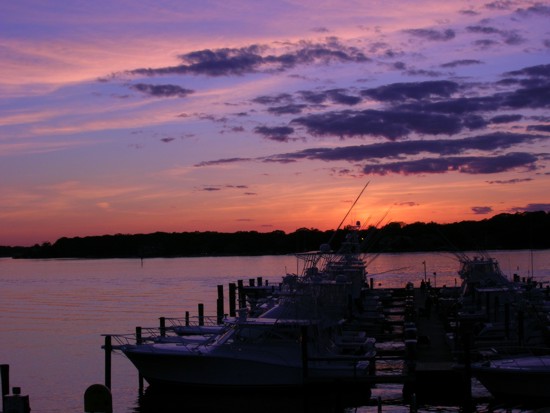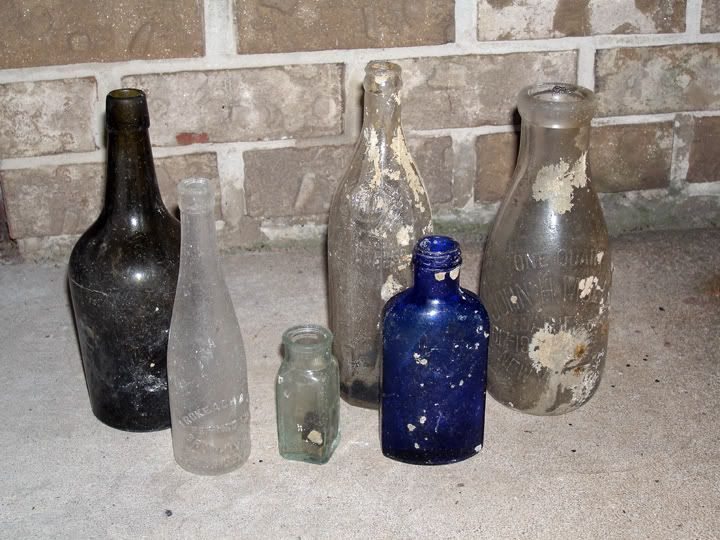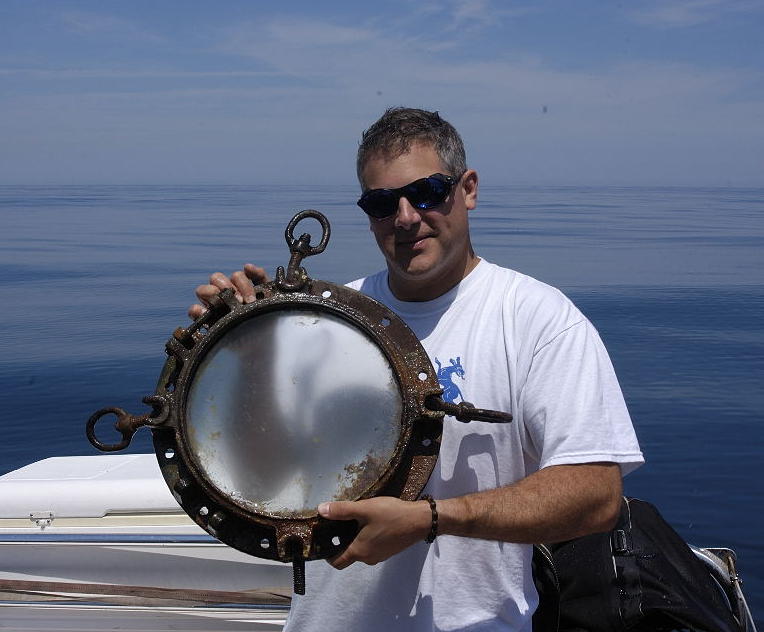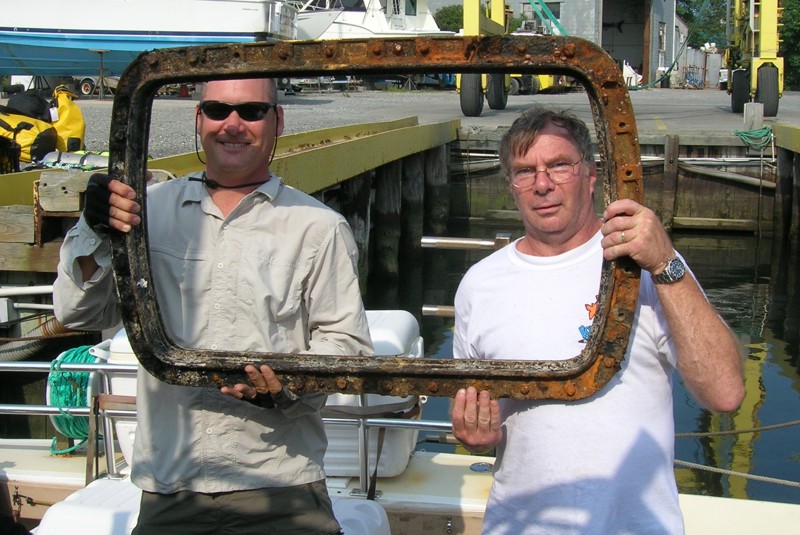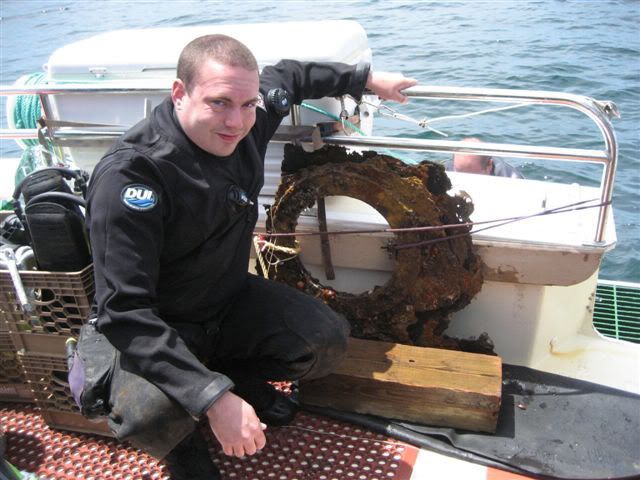| [singlepic=158,400,300] |
| Prop and shaft |
Due to a last minute cancellation, I was able to jump on Richie Kohler’s wreck exploration trip down to Savanna Georgia. Richie and Captain Dan were the crew for the trip. The passengers included Dive Marshall Bill and myself, along with a few of Richie’s students from Canada, and Arizona. The captain was a long time local fishing operator with a long list of hang numbers from 40’ to 300’.
Bill was driving down, and was kind enough to offer transportation of our gear. Since work has been nuts this last month, this allowed me a few extra days before getting underway. We met at the hotel on Friday night, and discussed the plans. We had an assortment of CCRs aboard, and a token OC diver to keep the sharks away.
In this area the slope of the bottom is very shallow, even 30 miles out the depth is only 100ft. Many of the numbers were in 40 – 80 ft. At that depth, decompression is not a consideration, and in 78 degree water, hypothermia is not either. The main issue getting back to the dive shop before it closes.
We loaded up the boat in the morning, and headed out towards Ossabaw Sound. The first set of number (known as secret spot 32) was not so secret. There was a local fishing tournament in progress, and the area was teaming with boats. One boat was anchored over the exact numbers. We moved far enough away to give the boat room, but still could see relief on the depth finder. Richie dropped in to check it out. The ball started moving off then we saw the tell tail bubbles (never good). It turned out to be reef rather than a wreck. I was unaware that Georgia had reefs, but apparently they do, and this one had 20ft of relief. Personally, I would have jumped in to take some pictures, but the rest of the crew was looking for wrecks. The decision was made to head out for another set of numbers.
| [singlepic=159,400,300] |
| Tied into … the anchor |
To make a long story short, we hit a number of hangs before landing on a nice wreck in 45 ft of water. Of all things, Richie had us tied into the anchor which was located next to a large boiler. The wreck was covered in sponge, hard coral, and gorgonians. Navigation was easy in the 50’ visibility. Several rows of beams headed off toward the bow. Obviously behind the boiler was the engine prop shaft, and prop. A large school of spadefish hung just above the wreck. Barracuda were here and there, often gathering into an ominous school of their own. Within the wreck, particularly the boilers were large grouper waiting for prey. My old friends the seabass were out and about, along with a few large fluke. It was odd to see them swimming around with angle fish, and trigger fish. I expected to see a few lionfish, but there were none to be found.
| [singlepic=161,400,300] |
| An ominous looking school of baracuda |
Swimming about, I found the other divers fanning in the sand near the boiler, engine and around the various wreck structures. When my camera flashed, Richie popped his head out of a cloud of silt with a brass valve in hand. Others held various pieces of porcelain and brass. I entertained myself behind the viewfinder.
Up north, we don’t often get to see wrecks with this amount of light and visibility. Shallow inshore wrecks have the light, but the vis is short. Offshore, deep wrecks have the vis, but there is little ambient light. This was a nice compromise, and I wanted to take advantage of it. The school of spadefish seemed willing to paint a picturesque background for most of the shots. The Barracuda also appeared willing to add to the shots subject matter. This was good, as the divers were too busy to model.
| [singlepic=166,400,300] |
| A school of spadefish paint a backdrop |
At the allotted time, we started up, and back to the dock. Plans were made for the next day. We cleaned our gear, and headed to bed. It had been a long day.
The offshore forecast was not cooperating, so the next morning we boarded the boat and headed north to Hilton Head. There was an inshore wreck there reported to be producing china and bottles. Upon arrival, Richie jumped in to tie us in. Again this was a shallow wreck at 30 ft with about 15 ft of relief. Had it been in the channel, it would have been a hazard to navigation. We let the other passengers clear the deck, then geared up and splashed.
According to Richie, we were tied into a winch at the bow. I’ll take his word for it, as I could not identify much. The visibility was varied anywhere from 2 feet to 2 inches. Inflatable Water Slide The skin of the ship was clear, as were the massive boilers and engine. I tried to find my way back to the props, but was unable to navigate clearly. I kept ending up back at the up line. I tried going along the skin of the ship, but kept finding myself in washouts in pitch black. (Pitch black, and 2 ft of vis is not my idea of fun.) Then I tried to go along the top of the vessel. Here there was light, and lots of spadefish. After passing the boilers, and what appeared to be the engine, I was be back over sand again.
| [singlepic=168,400,300] |
| A toadfish I think |
After the fourth attempt to find the stern, I heard the worst sound a diver can experience, the boats engines (never good). The engine pattern did not sound like a recall. Perhaps a diver had come up down current, and the boat had to go after him. This would mean that they would go off, then come back and shut down. I reeled in the line slowly heading back. By the time I reached the up line, it was clear that something was wrong. The engines had been running too long. It was also clear that there was no tension on the up-line.
I ascended to find the boat a short way off, the line had parted, and they were adrift. Once I was on the surface they threw me a line, which I quickly attached to the up-line, handed back up. I swam off and waited for the engines to shutdown. Once onboard, Dan explained the details of the incident.
Richie had used a Polypropylene (poly) line for the tie in rather than the standard nylon. Poly line has some advantages in price, and the fact that it floats. On the other hand it does not stretch like nylon, is not as abrasion resistant as nylon, and does not have the strength of nylon. Elastic stretch is good for an anchor line as it absorbs the stress of boat pitching up and down in the waves. In these rough conditions the line had overstressed and chaffed at the bow cleat, and snapped. Lesson learned.
The last few divers eventually appeared. They had varying degrees of success in the hunt for bottles and glassware. None had paid much attention to the sound of the engines.
We strapped down for the trip back to Georgia, and then broke out lunch and hops infused beverages. Richie presented an antique bottle to the captain, who mentioned mounting it with a plaque about “when the rebreathers came to town”.
With the weather picking up, Bill decided to head down to Ginny Springs for a few cave dives. some of the group decided to join him. However, work was calling so Captain Dan and I opted to head home. Back to those NJ wrecks.
